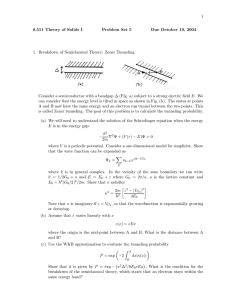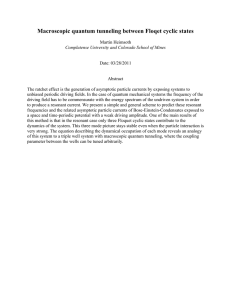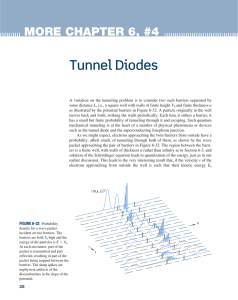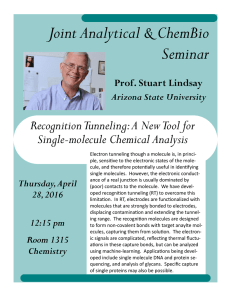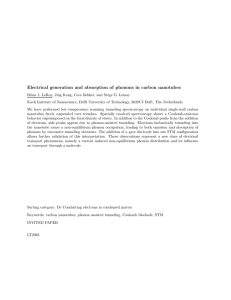Resonant tunneling as a dominant transport mechanism in n
advertisement
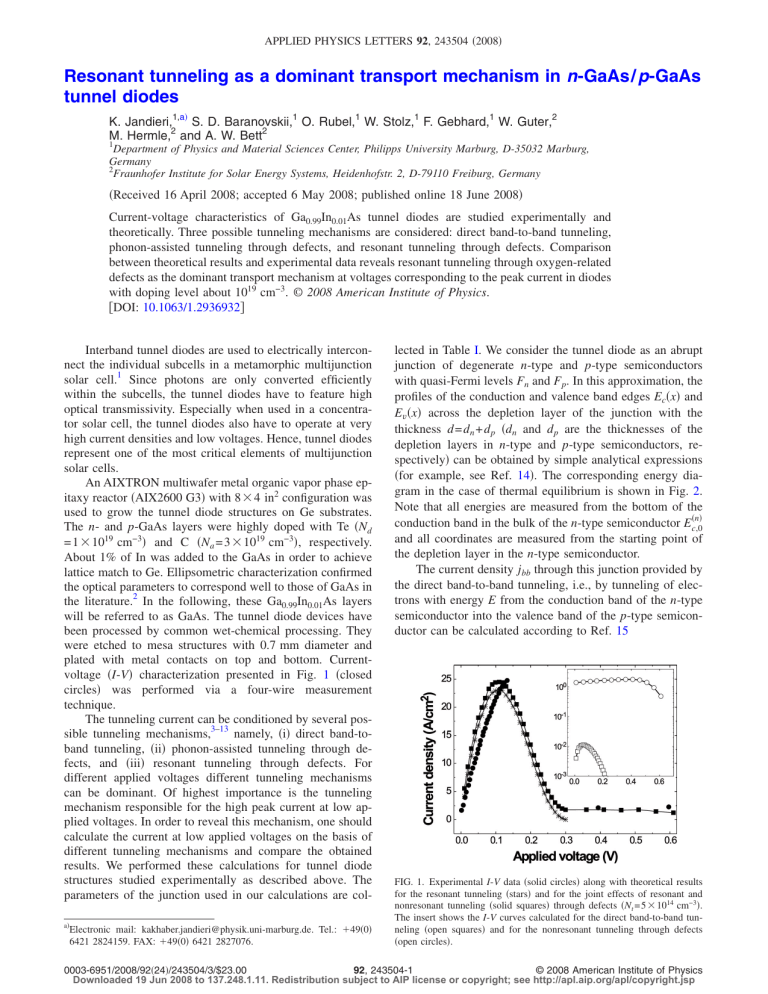
APPLIED PHYSICS LETTERS 92, 243504 共2008兲 Resonant tunneling as a dominant transport mechanism in n-GaAs/ p-GaAs tunnel diodes K. Jandieri,1,a兲 S. D. Baranovskii,1 O. Rubel,1 W. Stolz,1 F. Gebhard,1 W. Guter,2 M. Hermle,2 and A. W. Bett2 1 Department of Physics and Material Sciences Center, Philipps University Marburg, D-35032 Marburg, Germany 2 Fraunhofer Institute for Solar Energy Systems, Heidenhofstr. 2, D-79110 Freiburg, Germany 共Received 16 April 2008; accepted 6 May 2008; published online 18 June 2008兲 Current-voltage characteristics of Ga0.99In0.01As tunnel diodes are studied experimentally and theoretically. Three possible tunneling mechanisms are considered: direct band-to-band tunneling, phonon-assisted tunneling through defects, and resonant tunneling through defects. Comparison between theoretical results and experimental data reveals resonant tunneling through oxygen-related defects as the dominant transport mechanism at voltages corresponding to the peak current in diodes with doping level about 1019 cm−3. © 2008 American Institute of Physics. 关DOI: 10.1063/1.2936932兴 Interband tunnel diodes are used to electrically interconnect the individual subcells in a metamorphic multijunction solar cell.1 Since photons are only converted efficiently within the subcells, the tunnel diodes have to feature high optical transmissivity. Especially when used in a concentrator solar cell, the tunnel diodes also have to operate at very high current densities and low voltages. Hence, tunnel diodes represent one of the most critical elements of multijunction solar cells. An AIXTRON multiwafer metal organic vapor phase epitaxy reactor 共AIX2600 G3兲 with 8 ⫻ 4 in2 configuration was used to grow the tunnel diode structures on Ge substrates. The n- and p-GaAs layers were highly doped with Te 共Nd = 1 ⫻ 1019 cm−3兲 and C 共Na = 3 ⫻ 1019 cm−3兲, respectively. About 1% of In was added to the GaAs in order to achieve lattice match to Ge. Ellipsometric characterization confirmed the optical parameters to correspond well to those of GaAs in the literature.2 In the following, these Ga0.99In0.01As layers will be referred to as GaAs. The tunnel diode devices have been processed by common wet-chemical processing. They were etched to mesa structures with 0.7 mm diameter and plated with metal contacts on top and bottom. Currentvoltage 共I-V兲 characterization presented in Fig. 1 共closed circles兲 was performed via a four-wire measurement technique. The tunneling current can be conditioned by several possible tunneling mechanisms,3–13 namely, 共i兲 direct band-toband tunneling, 共ii兲 phonon-assisted tunneling through defects, and 共iii兲 resonant tunneling through defects. For different applied voltages different tunneling mechanisms can be dominant. Of highest importance is the tunneling mechanism responsible for the high peak current at low applied voltages. In order to reveal this mechanism, one should calculate the current at low applied voltages on the basis of different tunneling mechanisms and compare the obtained results. We performed these calculations for tunnel diode structures studied experimentally as described above. The parameters of the junction used in our calculations are colElectronic mail: kakhaber.jandieri@physik.uni-marburg.de. Tel.: ⫹49共0兲 6421 2824159. FAX: ⫹49共0兲 6421 2827076. a兲 lected in Table I. We consider the tunnel diode as an abrupt junction of degenerate n-type and p-type semiconductors with quasi-Fermi levels Fn and F p. In this approximation, the profiles of the conduction and valence band edges Ec共x兲 and Ev共x兲 across the depletion layer of the junction with the thickness d = dn + d p 共dn and d p are the thicknesses of the depletion layers in n-type and p-type semiconductors, respectively兲 can be obtained by simple analytical expressions 共for example, see Ref. 14兲. The corresponding energy diagram in the case of thermal equilibrium is shown in Fig. 2. Note that all energies are measured from the bottom of the 共n兲 conduction band in the bulk of the n-type semiconductor Ec,0 and all coordinates are measured from the starting point of the depletion layer in the n-type semiconductor. The current density jbb through this junction provided by the direct band-to-band tunneling, i.e., by tunneling of electrons with energy E from the conduction band of the n-type semiconductor into the valence band of the p-type semiconductor can be calculated according to Ref. 15 FIG. 1. Experimental I-V data 共solid circles兲 along with theoretical results for the resonant tunneling 共stars兲 and for the joint effects of resonant and nonresonant tunneling 共solid squares兲 through defects 共Nt = 5 ⫻ 1014 cm−3兲. The insert shows the I-V curves calculated for the direct band-to-band tunneling 共open squares兲 and for the nonresonant tunneling through defects 共open circles兲. 0003-6951/2008/92共24兲/243504/3/$23.00 92, 243504-1 © 2008 American Institute of Physics Downloaded 19 Jun 2008 to 137.248.1.11. Redistribution subject to AIP license or copyright; see http://apl.aip.org/apl/copyright.jsp 243504-2 Appl. Phys. Lett. 92, 243504 共2008兲 Jandieri et al. TABLE I. Parameters of n-GaAs/ p-GaAs homojunction in thermal equilibrium. Parameter Value Nd Na E ga ⑀a m na mha p mlpa d dn dp Fn = F p 1019 cm−3 3 ⫻ 1019 cm−3 1.43 eV 12.9 0.063me 0.051me 0.082me 175 Å 135 Å 40 Å 0.232 eV jt = e a e 2ប 冕 d Rt共x兲dx, 共3兲 0 Reference 2. jbb = The tunneling through defects can occur via two different processes: phonon-assisted tunneling3–10 and resonant tunneling.5,11–13 The current jt provided by the phononassisted tunneling can be considered as a tunnel-assisted recombination on the trap state Et associated with the defect in the depletion layer of the junction.9,10 Instead of thermal emission over the entire trap depth, which is the only escape mechanism possible in the absence of the electric field in the junction, in real p-n junctions carriers can also be emitted by thermal excitation over only a fraction of the trap depth, followed by tunneling through the remaining potential barrier. It is also true for the recombination process on the trap. Consequently, jt can be calculated according to 冕 E共p兲 v,0 关n2D共Fn − E兲 − n2D共F p − E兲兴TD共E兲dE, 0 共1兲 where n2D共E兲 = 共mk0T/ប 兲ln共1 + e 2 E/k0T 兲 共2兲 represents the density of electrons in a two-dimensional electron gas, m is the effective mass, k0 is the Boltzmann constant, T is the lattice temperature, and E共p兲 is the valence v,0 band edge in the bulk of the p-type semiconductor. The transmission coefficient TD through the potential barrier can be calculated either using the Wentzel–Kramers–Brillouin approximation,16 or the global transfer matrix technique.17,18 We use the latter approach. This method requires to approximate the actual potential profile by a set of narrow regions of constant potential in a stepwise manner. Then, the total transfer matrix and the total transmission coefficient through the arbitrary shaped potential barrier can be calculated by sequential multiplication of partial transfer matrices, each characterizing the transfer of an electron through the individual rectangular potential barrier. The results of our calculations in the case of direct band-to-band tunneling are presented in Fig. 1 共open squares in the insert兲. One can see that the calculated current is too low to explain the experimental data. Therefore, direct band-to-band tunneling cannot account for the high peak current and tunneling through defects should be considered. where the tunneling-assisted recombination coefficient Rt can be calculated by the modified Shockley–Read–Hall formula,9,10 where instead of conventional lifetimes of the electrons n and holes p, the effective lifetimes eff n = n / 共1 + ⌫n兲 and eff = / 共1 + ⌫ 兲 are used. These effective lifetimes p p p are reduced due to tunneling effects by the factors9,10 ⌫n = 共k0T兲−1 冕 ⌬En eE/k0TTD共E兲dE, 共4a兲 eE/k0TTD共E兲dE, 共4b兲 0 ⌫ p = 共k0T兲−1 冕 ⌬E p 0 where for a given spatial location of the trap Et共x兲, the integration limit ⌬En is determined by the difference between the local edge Ec共x兲 of the conduction band, and either Et共x兲 共n兲 depending on which of them is closer to Ec共x兲. The or Ec,0 same can be said for ⌬E p, considering Ev共x兲 instead of Ec共x兲 instead of E0c . and E共p兲 v,0 In order to calculate the defect-assisted tunnel current, one has to know the energy level of the defect centers and the recombination lifetimes of electrons and holes, controlled by these centers. We assume that the major defects in our structures are similar to the oxygen-related defects with energy level Et = −0.75 eV Ref. 19 homogeneously distributed in the depletion layer of the n-GaAs/ p-GaAs junction with concentrations below Nt ⬃ 1015 cm−3. The recombination lifetimes were determined according to their relation to the corresponding recombination coefficients n and  p: n = 共Ntn兲−1, p = 共Nt p兲−1. The value n ⯝ 7 ⫻ 10−9 cm3 s−1 is known.19 The value  p for oxygen-related centers in GaAs is, however, not known precisely. Our calculations show that the variation of  p in the range from  p ⯝ 5 ⫻ 10−10 to 5 ⫻ 10−9 cm3 s−1 does not change the current-voltage characteristics essentially and that current in the case of light holes is significantly higher than that for heavy holes. Light holes contribute more than heavy holes to the tunnel-assisted currents due to their larger effective radius. Since the effective mass of the light holes mlp ⯝ 0.082me differs only slightly from that of electrons mn ⯝ 0.063me, and since the oxygenrelated energy level in GaAs is situated nearly in the middle of the energy gap, the values of  p chosen close to n seem to be reasonable. The results of our calculations are sensitive to the choice of the defect concentration. By taking different values of Nt and comparing the obtained theoretical results with the experimental data, one can conclude that the values FIG. 2. Energy diagram of n-GaAs/ p-GaAs homojunction in the thermal equilibrium. Downloaded 19 Jun 2008 to 137.248.1.11. Redistribution subject to AIP license or copyright; see http://apl.aip.org/apl/copyright.jsp 243504-3 Appl. Phys. Lett. 92, 243504 共2008兲 Jandieri et al. of the observed peak current could be achieved in the regime of nonresonant tunneling assuming the concentration of defects as high as Nt ⯝ 8 ⫻ 1015 cm−3. This concentration seems unreasonably large. Moreover, even in such a case, the voltage corresponding to the maximum of the current would be much higher than the one observed experimentally and shown in Fig. 1. Furthermore, at such high defect concentrations the resonant tunneling process considered below would give much larger currents than those obtained by the expression 共3兲. The insert of Fig. 1 shows the I-V dependence 共open circles兲 obtained in the case of nonresonant tunneling through defects with  p = 2 ⫻ 10−9 cm3 s−1 and Nt = 5 ⫻ 1014 cm−3. Although the values of the current density obtained on the basis of the defect-assisted nonelastic tunneling are much higher than those in the case of direct band-to-band tunneling 共open squares兲, they are still much lower than the experimentally obtained values 共solid circles兲. On the other hand, as it will become clear from below, for Nt = 5 ⫻ 1014 cm−3 the resonant tunneling through oxygen-related defects would give a good agreement between the theoretical results and the experimental data. Therefore, one can exclude nonresonant currents as dominant process in the range of voltages corresponding to the peak current. Let us now turn to the resonant tunneling through defects. We use the model proposed in Ref. 13. According to this model, a defect in a tunnel junction can be represented by a square potential well dividing the whole potential barrier into two potential barriers. Then, the resonant tunneling through defects can be considered as a double barrier problem. The electron transmission coefficient Ttot for one type of defects with the concentration Nt and the capture cross section is given by13 Ttot = N2/3 t Tres , 共5兲 where the resonant transmission coefficient Tres is given by Tres = T1T2共1 + R1R2 − 2冑R1R2 cos ⌽兲−1 . 共6兲 T1 and T2 are the transmission coefficients through potential barriers surrounding the potential well 共representing the defect兲 at the left and right sides, respectively, R1 = 1 − T1 and R2 = 1 − T2 are the corresponding reflection coefficients from the barriers and ⌽ = 2kdW + 1 + 2 is the phase angle determined by the electron wave number k in the well, dW is the width of the well, and 1 and 2 are the phase changes during the reflection from the left and the right walls of the well, respectively. The corresponding current density can be calculated according to Eq. 共1兲 although using Ttot from Eq. 共5兲 instead of TD. The resonance takes place at energy Eres that satisfies the condition ⌽ = 2n with integer n. The transmission rises dramatically near the resonance and it reaches its maximum value of unity if the structure is symmetric in the sense that T1 = T2, when there is perfect total transmission through the double barrier whatever opaque the individual barriers can be. In the case of a uniform distribution of defects in the junction, the condition of maximum resonant current depends on the applied voltage Vapp and on the energy level of the defect Et. Besides, according to Eqs. 共5兲 and 共6兲, other important parameters for calculation of the resonant tunneling current are the capture cross section and the defect concentration Nt. The cross-section can be determined according to = n共v̄T兲−1, where v̄T is the thermal velocity of an isolated electron. For defects with Et = −0.75 eV at T = 300 K we have ⯝ 7 ⫻ 10−16 cm2 which is in good agreement with experimental data.19 Our calculations show that the resonant tunneling is able to account for the observed peak current at the appropriate applied voltage, provided the value of Nt is about 5 ⫻ 1014 cm−3. This value is considerably less than the oxygen detection limit of ⬃1015 cm−3 in the secondary-ion-mass spectroscopy measurements performed. The corresponding I-V dependences in the case of the resonant tunneling through defects 共stars兲 as well as in the case of joint consideration of resonant and nonresonant tunneling 共solid squares兲 are shown in Fig. 1. By comparing these results to experimental data 共solid circles兲, we come to the conclusion that the resonant tunneling is the dominant transport mechanism at voltages corresponding to the peak current. Furthermore, a comparison between experimental data and the theoretical calculations reveals the concentration of defects Nt in the sample under study. Financial support of the Fonds der Chemischen Industrie, of the Deutsche Forschungsgemeinschaft and of the European Graduate Program “Electron-electron interactions in solids” is gratefully acknowledged. This work was supported in part by the European Commission through the funding of the project FULLSPECTRUM 共SES6-CT-2003-502620兲. The work of W. Guter is supported by the Deutsche Bundesstiftung Umwelt. 1 T. Takamoto, E. Ikeda, H. Kurita, and M. Ohmori, Appl. Phys. Lett. 70, 381 共1997兲. 2 M. E. Levinshtein and S. L. Rumyantsev, Handbook Series on Semiconductor Parameters 共World Scientific, London, 1996兲, Vol. 1. 3 A. Schenk, J. Appl. Phys. 71, 3339 共1991兲. 4 A. Schenk, Solid-State Electron. 36, 19 共1993兲. 5 M. Herman and A. Schenk, J. Appl. Phys. 77, 4522 共1995兲. 6 M. Stadele, B. Fischer, B. R. Tuttle, and K. Hess, Superlattices Microstruct. 28, 517 共2000兲. 7 M. Stadele, B. R. Tuttle, and K. Hess, J. Appl. Phys. 89, 348 共2001兲. 8 M. Stadele, B. Fischer, B. R. Tuttle, and K. Hess, Solid-State Electron. 46, 1027 共2002兲. 9 G. A. M. Hurkx, D. B. M. Klaassen, and M. P. G. Knuvers, IEEE Trans. Electron Devices 39, 331 共1992兲. 10 G. A. M. Hurkx, H. C. de Graaff, W. J. Kloosterman, and M. P. G. Knuvers, IEEE Trans. Electron Devices 39, 2090 共1992兲. 11 J. W. Gadzuk, J. Appl. Phys. 41, 286 共1969兲. 12 B. Ricco, M. Y. Azbel, and M. H. Brodsky, Phys. Rev. Lett. 51, 1795 共1983兲. 13 C. W. Jiang, M. A. Green, E. C. Cho, and G. Conibeer, J. Appl. Phys. 96, 5006 共2004兲. 14 N. W. Ashcroft and N. D. Mermin, Solid State Physics 共Holt, Rinehart & Winston, New York, 1976兲, p. 596. 15 L. Esaki, Phys. Rev. 109, 603 共1958兲. 16 L. D. Landau and E. M. Lifshitz, in Quantum Mechanics 共Pergamon, Oxford, 1962兲. 17 R. Redhammer and F. Urban, Phys. Status Solidi B 182, 133 共1994兲. 18 J. Racko, A. Grmanova, J. Parizek, and J. Breza, Czech. J. Phys. 47, 649 共1997兲. 19 D. V. Lang and C. H. Henry, Phys. Rev. Lett. 35, 1525 共1975兲. Downloaded 19 Jun 2008 to 137.248.1.11. Redistribution subject to AIP license or copyright; see http://apl.aip.org/apl/copyright.jsp
